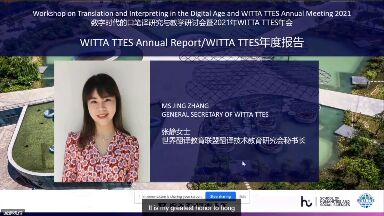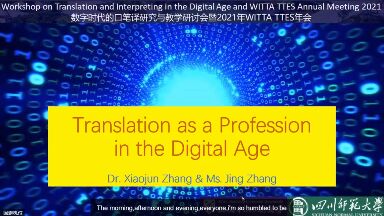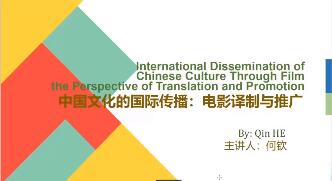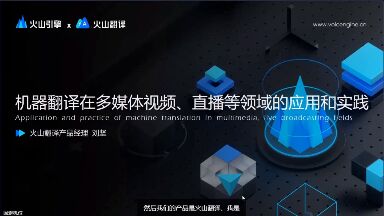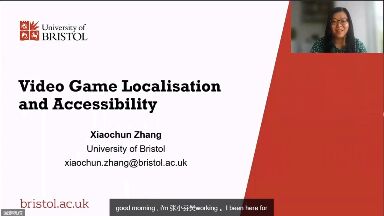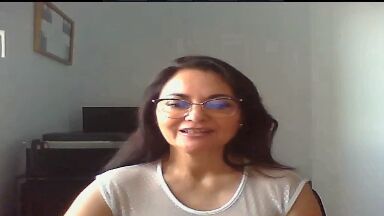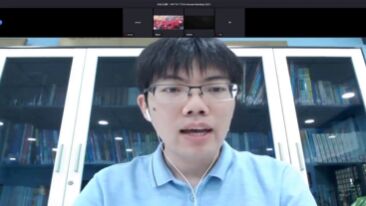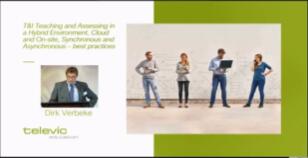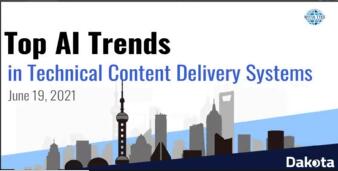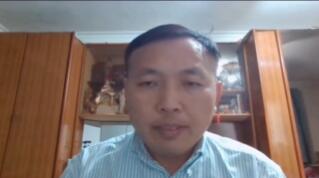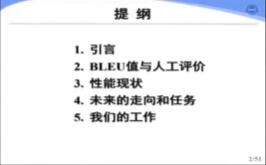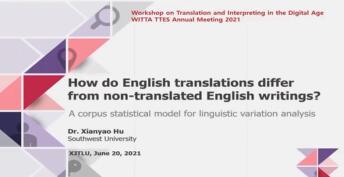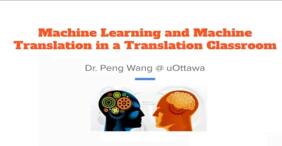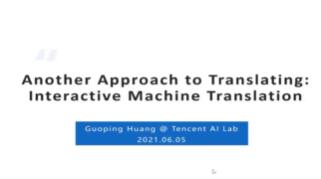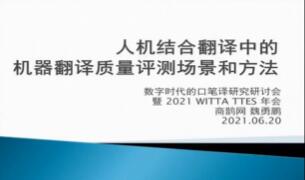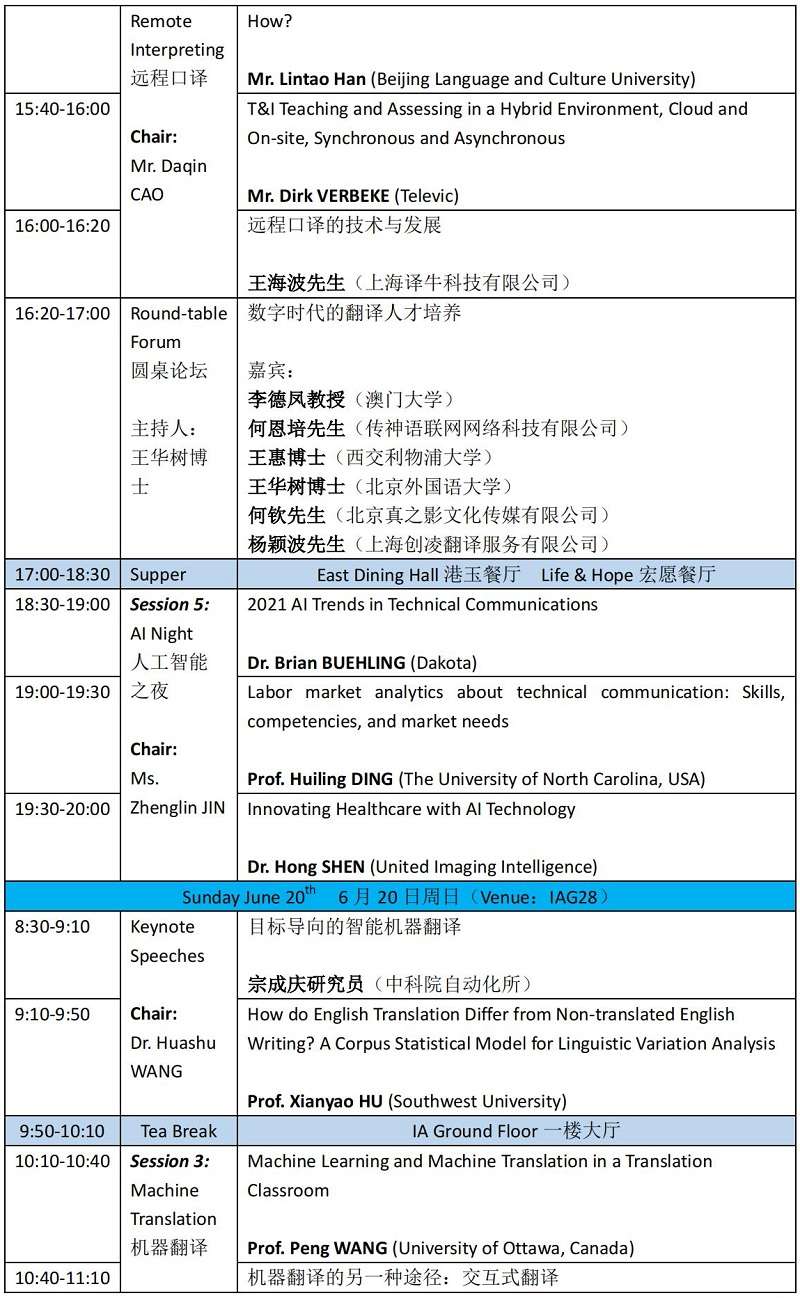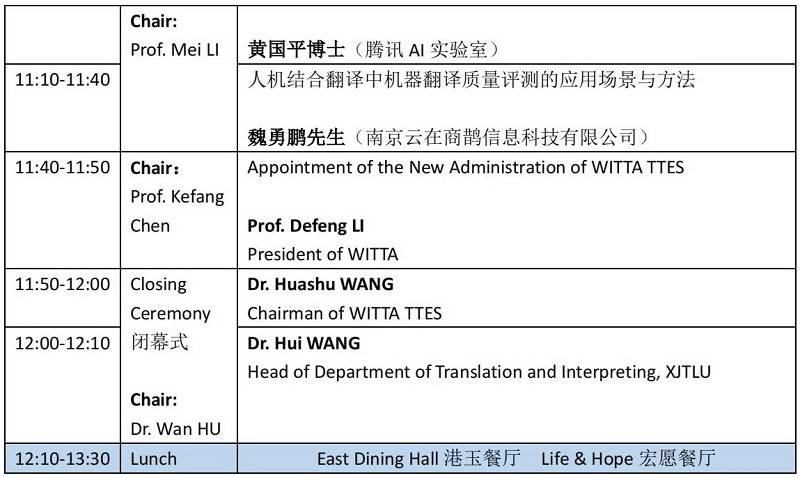 26180
26180
-
WITTA TTES年度报告
张静 00:12:16关闭 -
Translation as a profession in the Digital Age
Dr. Xiaojun ZHANG 00:28:34关闭 -
D时代,语言服务行业与翻译教育的变革
何恩培 00:36:00关闭 -
中国文化国际传播:电影译制与推广
何钦 00:30:38关闭 -
机器翻译技术在多媒体视频直播场景中的创新实践
刘坚 21-06-19关闭 -
Video Game Localization and Accessibility
Dr. Xiaochun ZHANG 00:30:02关闭 -
Beyond Your Wildest Dreams: Interpreting and Technology Today
Prof. Gloria Corpas PASTO 00:34:59关闭 -
关闭
-
T&I Teaching and Assessing in a Hybrid Environment, Cloud and On-site, Synchronous and Asynchronous
Mr. Dirk VERBEKE 00:15:18关闭 -
远程口译的技术与发展
王海波先生 00:20:01关闭 -
圆桌论坛:数字时代的翻译人才培养
Round -table Forum 01:04:03关闭 -
2021 AI Trends in Technical Communications
Dr. Brain BUEHLING 00:30:41关闭 -
Labor market analytics about technical communication: Skills, competencies, and market needs
Prof. Huiling DING 00:28:46关闭 -
Innovating Healthcare with AI Technology
Dr. Hong SHEN 00:25:24关闭 -
目标导向的智能机器翻译
宗成庆研究员 00:48:59关闭 -
How do English Translation Differ from Non-translated English Writing? A Corpus Statistical Model for Linguistic Variation Analysis
Prof. Xianyao HU 00:39:23关闭 -
Machine Learning and Machine Translation in a Translation Classroom
Prof. Peng WANG 00:29:42关闭 -
机器翻译的另一种途径:交互式翻译
黄国平博士 00:34:28关闭 -
人机结合翻译中机器翻译质量评测的应用场景和方法
魏勇鹏先生 00:33:20关闭 -
6月19日上午
完整回放 03:38:10
直播:6月19-20日
数字技术的应用及人工智能的飞速发展给翻译专业口笔译学科发展带来了巨大的挑战和机遇。在全新的数字时代下,如何以翻译实践的新模式作为切入点,在国际范围内为口笔译跨学科研究和人才培养提供创新方法和智力支撑成为亟待探讨的课题。西交利物浦大学翻译系借WITTA TTES 2021年会契机,拟于6月19-20日举办 “数字时代的口笔译教学与研究研讨会”。会议诚邀各位专家、学者及业界人士建言献策,共同应对数字时代的挑战,培养符合市场需求的口笔译人才,促进国内口笔译研究与国际前沿接轨。
学术指导:
全国翻译专业学位研究生教育指导委员会
世界翻译教育联盟
主办单位:
西交利物浦大学人文社科学院翻译系
世界翻译教育联盟翻译技术教育研究会
支持单位:
西安迪佳悟信息技术有限公司
达科塔系统软件(上海)有限公司
传神语联网网络科技股份有限公司
南京云在商鹊信息科技有限公司
上海译牛科技有限公司
会议主题:数字时代的口笔译教学与研究
议题:
l 机器翻译
l 远程口译
l 字幕翻译
l 游戏本地化
l 多媒体本地化
l 数字内容管理
l 翻译技术教学
时间:2021年6月19日-20日
地点:西交利物浦大学(苏州)
方式:线下会议(国外嘉宾线上参会)
费用:此次大会免收会务费(食宿及交通费用自理)
会议联系
周老师 15268468229
杨老师 18001551066
工作邮箱:translationworkshop@xjtlu.edu.cn
译直播@厦门精艺达
提供直播技术支持
Livestreaming Powered by
TTV.CN of Master Translations
![]()
Translation as a Profession in the Digital Age
Xiaojun ZHANG and Jing ZHANG
Abstract: French translation theorist, Prof. Daniel Gouadec foresaw the “future translation” in his monograph entitled Translation as A Profession that the translator will be equipped with the virtual reality devices to conduct their interactive translation, computer-aided interpreting and speech translation tasks with the technologies of cognitive computing, semantic retrieval, and massive terminology management, the researchers will make the empirical translation studies and assessment the translation quality as well. Most of the above technologies were not seen in 2007 when he published his book. So, how many scenarios did come true 15 years later? What kind of translation technologies will be popularized in the following years? How can the translation education meet the future demands of talents? What kind of knowledge should translation technology teachers equip with? How to train these knowledge contents to the current translators to upgrade their translation performances? And what else we can do to adapt the future translation?
Xiaojun ZHANG (张霄军) is an assistant professor at Xi’an-Jiaotong Liverpool University(XJTLU). He was a postdoctoral researcher in machine translation at ADAPT Centre of Dublin City University, Ireland and the subject leader in translation and interpreting at University of Stirling, UK before he joined in XJTLU. He is a PCC member of Association of Computational Linguistics (ACL) and the deputy chairman of WITTA TTES.
Jing ZHANG (张静) is an associate professor at Sichuan Normal University. She is the general secretary of WITTA TTES, director of Sichuan Translator’s Association and co-founder of Sichuan Translation Technology Forum.
D 时代,语言服务行业与翻译教育的变革
何恩培
摘要:人工智能、区块链、5G 等技术不断发展,迅速推动语言服务行业进入“新翻译”时代,近几年以神经网络翻译技术的突破,让语言服务行业的产能有指数级增长的可能性。演讲从新技术赋能语言服务行业的创新实践出发,系统梳理语言服务企业的颠覆性变化和未来发展方向,探讨新技术赋能翻译教学与人才培养的未来趋势,旨在为未来的翻译教育发展规划提供借鉴思考。
何恩培,中国翻译协会副会长、Transn 传神语联网网络科技股份有限公司创始人兼董事长,被评为国家科技部“创新人才”、中国软件行业十大风云人物等荣誉称号。带领 Transn 团队取得专利及软件著作成果超过 300 余项、并获批“国家文化和科技融合示范基地”,多次入选“国家文化出口重点企业”等 20 多项国家级、省部级荣誉。
中国文化国际传播:电影译制与推广
何钦
摘要:电影译制往往被认为是电影内容的翻译,电影翻译研究也常被局限于电影内容的翻译,这可能是大多数翻译研究者和译员并没有机会去了解和观摩电影制作流程所致,他们所看到的只是“电影成品”。从电影制作人的角度来看待电影翻译问题会有所不同,电影翻译也绝非只是内容翻译。翻译贯穿于电影制作和发行的整个流程,而如果是合拍片(co-production),翻译则还要深入到剧本创意、创作到制作、发行等更加完整的流程之中。本报告将以实例的形式展示中国电影对外推广中出现的种种翻译问题,探讨电影翻译人员的基本素养以及中国文化国际传播的翻译途径。
何钦,北京真之影文化传媒有限公司董事总经理、电影制片人、监制。现任中国影视翻译协会(筹)副主任委员、广东外语外贸大学和西北大学翻译硕士特聘导师、西藏民族大学文学院当代文学研究中心特聘研究员。曾任加拿大蒙特利尔电影节中国区短片选片员、约旦国际电影节常任评委、金鸡百花电影节影片推荐人、昆明金孔雀电影节特邀顾问等。
机器翻译技术在多媒体视频直播场景中的创新实践
刘坚
摘要:内容生产和线上视频直播的发展激发人们更多的创造力,让人们看见更大的世界。在短短数年内短视频呈现全球性爆发式增长,视频和直播场景中的翻译成为最主要的障碍,这为机器翻译提供了天然的舞台。本演讲将会探讨在视频和直播场景下,如何利用智能化机器翻译更快更好地完成翻译工作,如何利用智能化技术进行视频字幕自动化,实现高效跨语言理解,促进跨文化传播交流?在融媒体时代翻译专业未来如何将翻译与垂直领域深度融合实现创新发展?
刘坚,北京火山引擎科技有限公司火山翻译团队产品经理,主要负责火山翻译算法的商业化和企业级应用。
Video Game Localisation and Accessibility
Xiaochun ZHANG
Abstract: Video games have become ever-present in digital life today, with thousands of deeply invested players and fans. As a form of popular entertainment and impactful media, they influence and shape the global culture and way of life in contemporary digital society. Within a span of five decades, video games have evolved into a multi-billion-dollar industry, the economic and cultural globalisation of which has made video game localisation an essential part of the production cycle. While much effort in localisation has made video games linguistically accessible to players worldwide, not all games are accessible or fully accessible for players with physical and cognitive impairments. Game accessibility has become a priority in both industrial practice and academic research. This presentation will first provide an overview of the game localisation process and the major challenges in game localisation and accessibility. It will then discuss critical issues in making video games more accessible, focusing on the application of audio description in
video games.
Xiaochun ZHANG(张晓春) is a senior lecturer at University of Bristol, UK. Her research interesting covers game localization, subtitling, non-obstacle communication and language technology. Effort and Effect of Note-taking in Remote Consecutive Interpreting:
A Cognitive Research Drawing on Eye-tracking and Pen-tracking Data
Binghan ZHENG and Huolingxiao KUANG
Abstract: The paper investigates the interaction among source speech difficulty, interpreters’working experience and their note-taking behaviours in remote consecutive interpreting (CI). 20 professional interpreters and 29 student interpreters completed a CI task containing two easy segments and two hard segments from English (L2) to Chinese (L1), with their eye and pen movements being registered by a Tobii eye-tracker and a Wacom digital pen. The results show that: 1) participants allocated more cognitive and physical effort to do note-taking in the easy segments than in the hard ones; 2) professional interpreters took more notes than students by paying more visual attention to the area of notes and bearing higher physical load during note-taking. However, the two groups showed no difference in the cognitive load of note-taking; 3) the participants’ NASA-TLX rating data reveals that the effects of source speech difficulty and interpreting experience were caused by the interpreters’ perceived levels of task difficulty and their self-perceived ability in completing this interpreting task. Professional interpreters and student interpreters perceived a similar level of task difficulty and frustration during interpreting. While the professionals actively addressed the difficulty issue, students chose to retreat. These findings demonstrate: 1) the importance of adopting flexible note-taking strategies for source speeches at different difficulty levels; 2) the key role that self-perceived ability plays in deciding the interpreters’ motivation and engagement in completing interpreting tasks. To the best of our knowledge, this is the first study to investigate the modulation of source speech difficulty and interpreter working experience on note-taking behaviours in CI. It also synthesizes eye-tracking and pen-tracking measures that can be adopted as the indexes of cognitive and physical effort of note-taking during remote CI.
Binghan ZHENG (郑冰寒) is an associate professor at Durham University, UK and the Chair of the British Chinese Language Teaching Society (BCLTS) which is an organization of Chinese language teachers in British universities. He is also directing the Centre for Intercultural Mediation of Durham University, and acting as the convenor of the Translation and Linguistics research group based on the School of Modern Languages and Cultures.
Huolingxiao KUANG (况霍凌霄) is a PhD student in translation studies at Durham University, UK.
Beyond your Wildest Dreams: Interpreting and Technology Today
Gloria Corpas PASTOR
Abstract: This talk will revolve around language technologies applied to interpreting. Nowadays there is a pressing need to develop interpreting-related technologies, with practitioners and other end-users increasingly calling for tools tailored to their needs and their new interpreting scenarios. With the advent of new technology, interpreters can work remotely, deliver interpreting in different modes and contexts, on many devices (phones, tablets, laptops, etc.), and even manage bookings and invoice clients with ease. But interpreting as a human activity has resisted complete automation for various reasons, such as fear, unawareness, communication complexities, lack of dedicated tools, etc.. In this talk, I will present recent R&D projects on interpreting technologies in action. The first one is a speech-to-text system for automating communication of English and Arabic speaking patients in Spanish hospital triage scenarios at A&E services (in progress). The second one is already close to completion. It comprises a suite of NLP-enhanced tools and resources for interpreters and trainees, including but not limited to, terminology tools, corpora building and processing, automatic glossary building, automatic speech recognition and training tools.
Gloria Corpas PASTOR is a Professor in Translation and Interpreting at the University of Malaga, Spain (since 2008), a Professor in Translation Technology at the Research Institute in Information and Language Processing (RIILP) of the University of Wolverhampton, UK (since 2007) and an Honorary Adjunct Professor at Xi'an Jiaotong-Liverpool University, China (since 2020). Her research lines cover computational and corpus-based phraseology, lexicography, corpus-based translation, and language technologies applied to translation and interpreting.
Teaching Programming to Translators and Interpreters: Why and How
Lintao HAN
Abstract: Thanks to the innovations in the field of artificial intelligence, machine translation along with many other technologies has infiltrated numerous aspects of translators’ lives. With more and more Artificial Intelligence technologies being open to the public via different Application Programming Interfaces (APIs), by using basic programming skills translators can easily benefit from updated artificial intelligence technologies, such as machine translation, optical character recognition, automatic speech recognition, etc. This talk presents a pilot study at Beijing Language and Culture University on providing a series of programming courses to students enrolled in the Bachelor of Translation and Interpreting program. From September 2015, courses covering Computer Basics, Website Development, Database Principle, Translation Technologies, Natural Language Processing are being specifically designed and provided to over 140 students. Cases will be demonstrated in this talk.
Lintao HAN (韩林涛) is a lecturer in translation technology and a PhD student in language technology at Chinese Language and Culture University. He is an expert member of WITTA TTES.
T&I Teaching and Assessing in a Hybrid Environment
Dirk VERBEKE
Abstract: Universities offering a master’s program for interpreting are in need of an environment simulating a real professional conference set up, but with a pedagogical approach for teaching, practicing and assessing. The development of on-line education and professional conference solutions, a combination of both technologies in one solution was the challenge. Based on feedback and research, in collaboration with Universities and professional institutions, in the field of interpreting, we have created a solution that meets these needs. COVID-19 has accelerated the need for remote teaching, on-line practicing, remote assessing for T&I in a hybrid environment using a mix of cloud, on- site, private cloud and public cloud services. Based on our experiences and combining our technologies we succeeded in creating new solutions. We will share with you our best practices of the last 6 months since COVID-19 and how to face the new reality in T&I teaching, practicing and assessing.
Dirk VERBEKE is the lead for interpreterQ, an embedded solution of Televic (Belgum), for simultaneous conference interpreter training, developed in close collaboration and with feedback from Universities worldwide.
远程口译的技术与发展
王海波
摘要:人类对于跨种族言语的沟通需求已经达到了历史新高,传统的图像、文字的沟通已经不能满足人类心灵层面的需求了!口译需求逐年增长,加之疫情的原因,远程口译需求被加速放大,需求迅速增长的同时带来了哪些技术的改进和推动?在进行远程口译的过程中哪些是经常被或略的问题,译牛科技是如何应对和解决的?结合远程同传的发展未来的口译教育该怎么发展?行业技术和口译教育怎么对接?口译人员需要具备什么样的技术能力?
王海波,译牛科技联合创始人兼COO。
2021 AI Trends in Technical Communications
Brian BUEHLING
Abstract: As companies strive to improve technical communications in 2021, it becomes important to understand the new Machine Learning (ML) Artificial Intelligence (AI) trends driving change in the industry. Three basic areas must be considered when evaluating how AI will affect technology content delivery systems. First, content creation involves building a single interface for authors, editors, and reviewers that handles multiple authoring tools. Second, content management involves storing document components, separating their content and structure from any formatting information to optimize re-use and facilitate dynamic distribution. Third, content distribution involves designing multiple channels to deliver the content to users including personalized printed pages, web pages, tablet applications and syndication engines. This session gives an overview of the AI trends in technical communications this year likely to drive changes in content delivery systems. From content creation and workflow control to document storage and online distribution, each structural component will be analyzed.
Brian BUEHLING is the Founder and Managing Director of Dakota Systems, a technology firm specializing in product content delivery with offices in Chicago and Shanghai. Prior to Dakota, he led content management system initiatives for several companies including Wolters Kluwer Health, John Deere and AT&T.
Labor market analytics about technical communication: Skills, competencies, and market needs
Huilin DING
Abstract: The socio-technological landscape of work has been radically and permanently changed by the ever-increasing application of artificial intelligence and automation tools. Driven by the increasingly important need to better understand the changing labor market, AI tools have been developed to use job postings as the proxy of real-time labor market information, which can have profound impacts on how our society responds to labor market trends and needs. This talk employs AI-driven labor market analytics to evaluate how technical communication, a field closely connected with translation studies, particularly technical translation, witnesses changing core competencies and skill gaps. I will shed light on the necessary skills, defining skills, and distinguishing skills that labor market analytics tools identified through natural language processing for the field of technical communication. Finally, issues related to the implications of these skill requirements for training and professionalization will be discussed.
Huiling DING (丁慧玲) teaches technical communication at North Carolina State University. Her research focuses on intercultural professional communication, technical communication, risk communication, and epidemic communication. Her recent projects have been exploring the connections between artificial intelligence, communication technologies, job screening, risk communication, and social justice.
Innovating Healthcare with AI Technology
Hong SHEN
Abstract: With the recent development of artificial intelligence (AI), namely the introduction of Deep Learning (DL), we foresee an enormous boost for healthcare innovation. In this talk, we aim to offer touches on such a trend with general insights and also concrete examples.
Hong SHEN (沈宏) is an experienced innovator in AI Healthcare, who developed the Siemens lung nodule detection application as early as 20 years ago, and have worked since then in various fields of this career. Before that he acquired his engineering Ph.D in USA, and returned to China more than 10 years ago. Most of the work was with Siemens China and USA, but he also worked for Microsoft for 2 years. In the recent years he has been active with AI healthcare startups.
目标导向的智能机器翻译
宗成庆
摘要:近年来机器翻译技术得到了快速发展,译文质量自动评价指标的BLEU值不断攀升。那么,BLEU值的高低与真实的译文质量水平存在怎样的对应关系?机器翻译技术现状如何?系统研发的未来方向是什么?本报告将通过具体实例和基于真实数据的统计分析对这些问题进行简要的阐述和分析,并对未来技术的发展做出展望。
宗成庆,中科院自动化所研究员、博士生导师,中国人工智能学会会士,中国计算机学会会士,主要从事自然语言处理、机器翻译、文本数据挖掘和认知语言计算等相关研究,主持国家项目 10 余项,是国家重点研发计划重点专项首席科学家,发表论文 200 余篇,出版专著和译著多部。他是国际计算语言学委员会(ICCL)委员,亚洲自然语言处理学会(AFNLP)主席,中国中文信息学会副理事长,国际顶级学术会议 ACL’2015 程序委员会主席和 ACL’2021大会主席。荣获国家科技进步奖二等奖一项和多个省部级及国家一级学会的科技奖励。荣获北京市优秀教师、中科院优秀导师等荣誉。享受国务院政府特殊津贴。
How do English Translation Differ from Non-translated English Writing?
A Corpus Statistical Model for Linguistic Variation Analysis
Xianyao HU
Abstract: This article discusses the debatable hypotheses of “Translation Universals”, i. e. the recurring typical features of translated texts in relation to original utterances. We propose that, if translational language does have some distinctive linguistic features in contrast to non-translated writings in the same language, those differences should be statistically significant, consistently distributed and systematically co-occurring across registers and genres. Based on the balanced Corpus of Translational English (COTE) and its non-translated English counterpart, the Freiburg-LOB corpus of British English (FLOB), and by deploying a multi-feature statistical analysis on 96 lexical, syntactic and textual features, we try to pinpoint those distinctive features in translated English texts. We also propose that the stylo-statistical model developed in this study will be effective not only in analysing the translational variation of English but also be capable of clustering those variational features into a “translational” dimension which will facilitate a crosslinguistic comparison of translational languages (e. g. translational Chinese) to test the Translation Universals hypotheses.
Xiaoyao HU (胡显耀) is a professor in corpus linguistics and the vice-dean of Foreign Languages School of Southwest University. His research interesting covers corpus linguistics, translation study, style statistics and applied linguistics.
Machine Learning and Machine Translation in a Translation Classroom
Peng WANG
Abstract: In the digital age, the language industry has been able to grow its linguistic assets exponentially as never before. When our language data has increased greatly in quantity and quality, the need for humans and machines sharing the linguistic resources is rising rapidly. This poses great challenges for traditional translation education, as humans and machines perceive language data in a completely different way. In this talk, I will discuss some fundamental framework and methodologies for humans to communicate with machines and how they can be applied in a translation training setting.
Peng WANG (王鹏) has been teaching, researching and practicing translation and localization in three continents. She is the convener for EDUinLOC, a part-time professor at the University of Ottawa, and a member of the Conference Interpretation Advisory Panel for the Translation Bureau of the Canadian government.
机器翻译的另一种途径:交互式翻译
黄国平
摘要:近年来,随着人工智能技术的快速发展,尤其以人工神经网络机器翻译技术的应用为标志,机器翻译的自动译文质量得到了显著提升。需要理性看待的是,机器翻译的本质是翻译知识的复用过程,而人工翻译才是新翻译知识的主要来源。另外,目前机器翻译仍然面临方方面面的挑战,难以独立满足需要严肃译文的场合要求。人机交互式机器翻译通过进一步促进人工翻译与机器翻译的融合以达到更高的翻译知识复用效率,同时帮助人工翻译大幅提升生产效率。本次发言将主要介绍机器翻译发展和交互翻译的核心技术,比如翻译输入法、实时补全与提示、动态机器翻译。以上文字(包括这句)由 Tencent TranSmart 翻译而成。
黄国平,腾讯 AI 实验室高级研究员,毕业于中国科学院自动化研究所,研究方向为机器翻译、自然语言处理。长年专注于人机交互式机器翻译的研究与应用,在 ACL、AAAI、IJCAI等人工智能领域顶级会议与 TASP 等顶级期刊发表论文 20 余篇。
人机结合翻译中机器翻译质量评测的应用场景和方法
魏勇鹏
摘要:人机结合翻译已经是语言服务行业新常态。在这个过程中,无论是人的方面,还是机器的方面,质量都是最为至关重要的因素。本报告从商鹊网的网络文学出海译前/译后编辑实践出发,说明机器翻译质量评测在其中的重要应用场景,并介绍所运用的几种机器翻译评测方法的基本原理和实践经验。
魏勇鹏,语智云帆、商鹊网联合创始人及首席技术官。毕业于清华大学计算机系人工智能实验室,现为中文信息学会机器翻译专委会委员、WITTA(世界翻译教育联盟)翻译技术教育研究会副会长、WITTA 大数据与语言智能教育专业委员会理事,中国翻译研究院术语管理技术顾问专家,北京外国语大学、同济大学、上海对外经贸大学等高校的 MTI 校外导师。
译直播@厦门精艺达
提供直播技术支持
Livestreaming Powered by
TTV.CN of Master Translations
![]()


 英语 EN
英语 EN